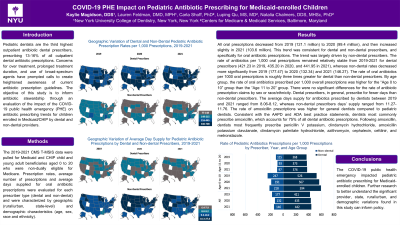Other
125 - COVID-19 PHE Impact on Pediatric Antibiotic Prescribing for Medicaid-enrolled Children


Kaylie R. Magidson, DDS
Pediatric Dental Resident
New York University, New York, NY
New York University
New York, New York, United States- LF
Lauren Feldman, DMD
NYU College of Dentistry
- CS
Carla Shoff, PhD
Centers for Medicare & Medicaid Services
- LQ
Luping Qu, MD, MS
Centers for Medicare and Medicaid Services
- NC
Natalia Chalmers, DDS, MHSc, PhD
Centers for Medicare and Medicaid Services
- LF
Lauren M. Feldman, DMD, MPH
Postdoctoral Program Director
NYU College of Dentistry, Pediatric Dental Department
New York, New York, United States
Presenting Author(s)
Co-Author(s)
Program Director(s)
Purpose: The study aims to evaluate the impact of the COVID-19 public health emergency on antibiotic prescribing trends for children enrolled in Medicaid/CHIP by dental and non-dental providers.
Methods: This retrospective cross-sectional analysis of oral antibiotic prescription claims data was conducted using the CMS T-MSIS dataset from 2019-2021 in children and adolescents up to 20 years old. Prescription rates, average number of prescriptions and average days supplied for oral antibiotic prescriptions were evaluated for each prescriber type (dental and non-dental) and were characterized by geographic (rural/urban, state-level) and demographic characteristics (age, sex, race and ethnicity). Additionally, it assessed prescribing trends linked to specific provider specialties where available.
Results: There was a noticeable decline in overall antibiotic prescriptions from 2019 to 2020, followed by a slight increase in 2021. The antibiotic prescriptions per 1,000 overall prescriptions are higher among dental providers than non-dental providers. For both provider types, the most frequently prescribed antibiotic was amoxicillin, which accounts for 75% of all dental antibiotic prescriptions and 35% of all non-dental antibiotic prescriptions. The rate of amoxicillin prescriptions was higher for general dentists compared to pediatric dentists. Dental providers are generally prescribing for fewer days (8 day average) compared to non-dental providers (12 day average). The rate of antibiotic prescriptions per 1,000 overall prescriptions is higher in rural than urban areas for prescriber types and Southern states.
Conclusions: The COVID-19 public health emergency impacted pediatric antibiotic prescribing for Medicaid-enrolled children. Significant provider, state, rural/urban, and demographic variations exist.
Identify Supporting Agency and Grant Number:
Research supported by HRSA grant K02HP30808.

.jpg)